Showing Spotlights 185 - 192 of 315 in category All (newest first):
 In contrast to the often depicted model of a perfect hexagonal lattice cylinder shape of carbon nanotubes, these nanomaterials often become twisted, bent or otherwise deformed during their growth, processing, or characterization. Researchers have found that some of these defects can be associated with a rearrangement of atoms and bonds which in turn will impact on the band structure and therefore affects the electronic properties of the tube. Previous experimental Atomic Force Microscopy and Transmission Electron Microscopy studies of carbon nanotubes have clearly identified their susceptibility to collapse and theoretical predictions of the impact that these deformations have on the electronic properties have been formulated. Experiments at the University of Surrey in the UK are the first to show atomically resolved radially collapsed double-walled carbon nanotubes, bringing also clear evidence of changes in the fundamental electronic behavior of these systems in response to the deformation.
In contrast to the often depicted model of a perfect hexagonal lattice cylinder shape of carbon nanotubes, these nanomaterials often become twisted, bent or otherwise deformed during their growth, processing, or characterization. Researchers have found that some of these defects can be associated with a rearrangement of atoms and bonds which in turn will impact on the band structure and therefore affects the electronic properties of the tube. Previous experimental Atomic Force Microscopy and Transmission Electron Microscopy studies of carbon nanotubes have clearly identified their susceptibility to collapse and theoretical predictions of the impact that these deformations have on the electronic properties have been formulated. Experiments at the University of Surrey in the UK are the first to show atomically resolved radially collapsed double-walled carbon nanotubes, bringing also clear evidence of changes in the fundamental electronic behavior of these systems in response to the deformation.
Oct 9th, 2008
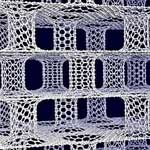 Safe, efficient and compact hydrogen storage is a major challenge in order to realize hydrogen powered transport. According to the U.S. Department of Energy Freedom CAR program roadmap, the on-board hydrogen storage system should provide 6 weight % of hydrogen capacity at room temperature to be considered for technological implementation. We have written several Nanowerk Spotlights where we introdduced and described novel, nanotechnology-based concepts for economically viable hydrogen storage methods. Scientists consider the storage of hydrogen in the absorbed form as the most appropriate way to solve the storage problem and one particular group of materials they have focused on are carbon nanomaterials like nanotubes or fullerenes. Offering a novel material approach, a theoretical investigation by researchers in Greece has shown that CNTs and graphene sheets could be combined to form novel 3-D nanostructures capable of enhancing hydrogen storage.
Safe, efficient and compact hydrogen storage is a major challenge in order to realize hydrogen powered transport. According to the U.S. Department of Energy Freedom CAR program roadmap, the on-board hydrogen storage system should provide 6 weight % of hydrogen capacity at room temperature to be considered for technological implementation. We have written several Nanowerk Spotlights where we introdduced and described novel, nanotechnology-based concepts for economically viable hydrogen storage methods. Scientists consider the storage of hydrogen in the absorbed form as the most appropriate way to solve the storage problem and one particular group of materials they have focused on are carbon nanomaterials like nanotubes or fullerenes. Offering a novel material approach, a theoretical investigation by researchers in Greece has shown that CNTs and graphene sheets could be combined to form novel 3-D nanostructures capable of enhancing hydrogen storage.
Oct 7th, 2008
 Back in the early 1800's it was observed that certain chemicals can speed up a chemical reaction - a process that became known as catalysis and that has become the foundation of the modern chemical industry. By some estimates 90% of all commercially produced chemical products involve catalysts at some stage in the process of their manufacture. Catalysis is the acceleration of a chemical reaction by means of a substance, called a catalyst, which is itself not consumed by the overall reaction. The most effective catalysts are usually transition metals or transition metal complexes. New nanotechnology research with carbon nanotubes coming out of Germany contains some implications for catalysis in general. Researchers at the Fritz Haber Institute of the Max Planck Society in Berlin have been working for some time at metal-free catalysis using nanocarbons. While their focus initially has been on ethylbenzene, an aromatic hydrocarbon that plays an important role as an intermediate in the production of various plastic materials, they now have, for the first time, used carbon nanotubes to activate butane.
Back in the early 1800's it was observed that certain chemicals can speed up a chemical reaction - a process that became known as catalysis and that has become the foundation of the modern chemical industry. By some estimates 90% of all commercially produced chemical products involve catalysts at some stage in the process of their manufacture. Catalysis is the acceleration of a chemical reaction by means of a substance, called a catalyst, which is itself not consumed by the overall reaction. The most effective catalysts are usually transition metals or transition metal complexes. New nanotechnology research with carbon nanotubes coming out of Germany contains some implications for catalysis in general. Researchers at the Fritz Haber Institute of the Max Planck Society in Berlin have been working for some time at metal-free catalysis using nanocarbons. While their focus initially has been on ethylbenzene, an aromatic hydrocarbon that plays an important role as an intermediate in the production of various plastic materials, they now have, for the first time, used carbon nanotubes to activate butane.
Oct 6th, 2008
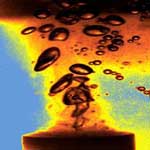 Since SWCNTs are sensitive to their chemical environment, they can be intentionally doped by a variety of dopants such as iron chloride, ammonia or nitrogen dioxide. But they can also be unintentionally doped. Scientists have known for some time that something funny happens when nanotubes are sonicated in certain solvents - sometimes their electronic properties change. Since mass produced nanotubes are clumped into bundles and ropes, they need to be dispersed prior to further processing in order to separate the individual nanotubes. A popular way of doing this is by exposing the CNT samples to ultrasonic pressure waves. Adding a dispersing reagent into the solution will accelerate the dispersion effect. New research now sheds light on how and why the electronic structure of carbon nanotubes changes during sonication.
Since SWCNTs are sensitive to their chemical environment, they can be intentionally doped by a variety of dopants such as iron chloride, ammonia or nitrogen dioxide. But they can also be unintentionally doped. Scientists have known for some time that something funny happens when nanotubes are sonicated in certain solvents - sometimes their electronic properties change. Since mass produced nanotubes are clumped into bundles and ropes, they need to be dispersed prior to further processing in order to separate the individual nanotubes. A popular way of doing this is by exposing the CNT samples to ultrasonic pressure waves. Adding a dispersing reagent into the solution will accelerate the dispersion effect. New research now sheds light on how and why the electronic structure of carbon nanotubes changes during sonication.
Sep 29th, 2008
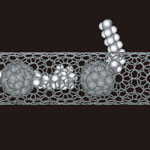 The processes by which molecules pass through pores in thin films and biological membranes are essential for understanding various physical, chemical and biological phenomena. For instance, the fundamental behavior of molecules in porous solids and their transfer through cell membranes necessarily involves a process of molecules passing through pores - knowledge that, for instance, is crucial for the development of nanotechnology-based hydrogen storage materials for fuel tanks. So far, research methods have been based on studying the statistical average of the behavior of groups of molecules; there were no experimental approaches that examined the interaction of a single molecule with a pore. There has been a lack of experimental methods that can obtain information on the structure and orientation of the molecules as they pass through a pore, and their interactions with the pore during passage. Researchers in Japan have now succeeded for the first time in observing a long chain of a fullerene-labeled hydrocarbon passing through a nanometer-size pore in the wall of a carbon nanotube as if it were alive.
The processes by which molecules pass through pores in thin films and biological membranes are essential for understanding various physical, chemical and biological phenomena. For instance, the fundamental behavior of molecules in porous solids and their transfer through cell membranes necessarily involves a process of molecules passing through pores - knowledge that, for instance, is crucial for the development of nanotechnology-based hydrogen storage materials for fuel tanks. So far, research methods have been based on studying the statistical average of the behavior of groups of molecules; there were no experimental approaches that examined the interaction of a single molecule with a pore. There has been a lack of experimental methods that can obtain information on the structure and orientation of the molecules as they pass through a pore, and their interactions with the pore during passage. Researchers in Japan have now succeeded for the first time in observing a long chain of a fullerene-labeled hydrocarbon passing through a nanometer-size pore in the wall of a carbon nanotube as if it were alive.
Sep 22nd, 2008
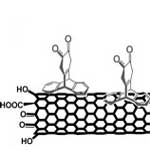 Pristine carbon nanotubes (CNTs) are insoluble in many liquids such as water, polymer resins, and most solvents. This means they are difficult to evenly disperse in a liquid matrix such as epoxies and other polymers, complicating efforts to utilize CNTs' outstanding physical properties in the manufacture of nanocomposite materials, as well as in other practical nanotechnology applications which require preparation of uniform mixtures of CNTs with many different organic, inorganic, and polymeric materials. To make nanotubes more easily dispersible in liquids, it is necessary to physically or chemically attach certain molecules, or functional groups, to their sidewalls without significantly changing the nanotubes' desirable properties. This process is called functionalization. Numerous nanotechnology research projects around the world are dedicated to developing various kinds of CNT-based electrochemical devices through the rational functionalization of CNTs.
Pristine carbon nanotubes (CNTs) are insoluble in many liquids such as water, polymer resins, and most solvents. This means they are difficult to evenly disperse in a liquid matrix such as epoxies and other polymers, complicating efforts to utilize CNTs' outstanding physical properties in the manufacture of nanocomposite materials, as well as in other practical nanotechnology applications which require preparation of uniform mixtures of CNTs with many different organic, inorganic, and polymeric materials. To make nanotubes more easily dispersible in liquids, it is necessary to physically or chemically attach certain molecules, or functional groups, to their sidewalls without significantly changing the nanotubes' desirable properties. This process is called functionalization. Numerous nanotechnology research projects around the world are dedicated to developing various kinds of CNT-based electrochemical devices through the rational functionalization of CNTs.
Sep 17th, 2008
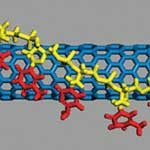 Current production methods for carbon nanotubes (CNTs) result in units with different diameter, length, chirality and electronic properties, all packed together in bundles, and often blended with some amount of amorphous carbon. These mixtures are of little practical use since many advanced applications, especially for nanoelectronics, are sensitively dependent on tube structures. Consequently, the separation of metallic and semiconducting CNTs is essential for future applications and studies. The tube diameter of semiconducting nanotubes is also important because the band gap depends on it. Separation of nanotubes according to desired properties is still proving to be a challenging task, especially single-walled carbon nanotube (SWCNT) sorting, because the composition and chemical properties of SWCNTs of different types are very similar, making conventional separation techniques inefficient. The separation techniques for SWCNTs explored to date rely on preferential electron transfer on metallic SWCNTs treated with diazonium salts, dielectrophoresis, enhanced chemical affinity of semiconducting SWCNTs with octadecylamine, and wrapping of SWCNTs with single-stranded DNA.
Current production methods for carbon nanotubes (CNTs) result in units with different diameter, length, chirality and electronic properties, all packed together in bundles, and often blended with some amount of amorphous carbon. These mixtures are of little practical use since many advanced applications, especially for nanoelectronics, are sensitively dependent on tube structures. Consequently, the separation of metallic and semiconducting CNTs is essential for future applications and studies. The tube diameter of semiconducting nanotubes is also important because the band gap depends on it. Separation of nanotubes according to desired properties is still proving to be a challenging task, especially single-walled carbon nanotube (SWCNT) sorting, because the composition and chemical properties of SWCNTs of different types are very similar, making conventional separation techniques inefficient. The separation techniques for SWCNTs explored to date rely on preferential electron transfer on metallic SWCNTs treated with diazonium salts, dielectrophoresis, enhanced chemical affinity of semiconducting SWCNTs with octadecylamine, and wrapping of SWCNTs with single-stranded DNA.
Sep 16th, 2008
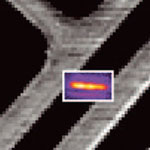 Carbon nanotubes are considered a promising material system not only for nanoelectronics but also for nanophotonics - the manipulation and emission of light using nanoscale materials and devices. By trying to understand the electrical properties of carbon nanotubes (CNTs) through their light emission, scientists are paving the way for CNTs' integration in optical applications. Embedding spatially isolated CNTs into an optical microcavity is a promising means of controlling and improving their radiative properties. The control of these CNT properties, including emission wavelength, spectral width, emission direction and radiative yield through optical confinement, opens the door for their use in integrated nanophotonic circuits. Cavity controlled nanotube emitters could potentially find use in quantum optics, quantum communication, and integrated nanophotonic circuits and may ultimately lead to low threshold on-chip nanolasers.
Carbon nanotubes are considered a promising material system not only for nanoelectronics but also for nanophotonics - the manipulation and emission of light using nanoscale materials and devices. By trying to understand the electrical properties of carbon nanotubes (CNTs) through their light emission, scientists are paving the way for CNTs' integration in optical applications. Embedding spatially isolated CNTs into an optical microcavity is a promising means of controlling and improving their radiative properties. The control of these CNT properties, including emission wavelength, spectral width, emission direction and radiative yield through optical confinement, opens the door for their use in integrated nanophotonic circuits. Cavity controlled nanotube emitters could potentially find use in quantum optics, quantum communication, and integrated nanophotonic circuits and may ultimately lead to low threshold on-chip nanolasers.
Sep 9th, 2008
 In contrast to the often depicted model of a perfect hexagonal lattice cylinder shape of carbon nanotubes, these nanomaterials often become twisted, bent or otherwise deformed during their growth, processing, or characterization. Researchers have found that some of these defects can be associated with a rearrangement of atoms and bonds which in turn will impact on the band structure and therefore affects the electronic properties of the tube. Previous experimental Atomic Force Microscopy and Transmission Electron Microscopy studies of carbon nanotubes have clearly identified their susceptibility to collapse and theoretical predictions of the impact that these deformations have on the electronic properties have been formulated. Experiments at the University of Surrey in the UK are the first to show atomically resolved radially collapsed double-walled carbon nanotubes, bringing also clear evidence of changes in the fundamental electronic behavior of these systems in response to the deformation.
In contrast to the often depicted model of a perfect hexagonal lattice cylinder shape of carbon nanotubes, these nanomaterials often become twisted, bent or otherwise deformed during their growth, processing, or characterization. Researchers have found that some of these defects can be associated with a rearrangement of atoms and bonds which in turn will impact on the band structure and therefore affects the electronic properties of the tube. Previous experimental Atomic Force Microscopy and Transmission Electron Microscopy studies of carbon nanotubes have clearly identified their susceptibility to collapse and theoretical predictions of the impact that these deformations have on the electronic properties have been formulated. Experiments at the University of Surrey in the UK are the first to show atomically resolved radially collapsed double-walled carbon nanotubes, bringing also clear evidence of changes in the fundamental electronic behavior of these systems in response to the deformation.
 Subscribe to our Nanotechnology Spotlight feed
Subscribe to our Nanotechnology Spotlight feed





